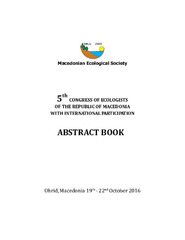Приказ основних података о документу
DNA damage and histological changes in gills and liver of cyprinid fish as biomarkers of the Sava River pollution
| dc.creator | Kostić, Jovana | |
| dc.creator | Kolarević, Stoimir | |
| dc.creator | Kracun-Kolarevic, Margareta | |
| dc.creator | Aborgiba, Mustafa | |
| dc.creator | Gacic, Zoran | |
| dc.creator | Raskovic, Bozidar | |
| dc.creator | Poleksic, Vesna | |
| dc.creator | Lenhardt, Mirjana | |
| dc.creator | Vuković-Gačić, Branka | |
| dc.date.accessioned | 2023-12-01T13:47:59Z | |
| dc.date.available | 2023-12-01T13:47:59Z | |
| dc.date.issued | 2016 | |
| dc.identifier.isbn | 978-9989-648-36-6 | |
| dc.identifier.uri | http://rimsi.imsi.bg.ac.rs/handle/123456789/2646 | |
| dc.description.abstract | Fish species living in freshwater ecosystems are exposed to a various range of xenobiotics. Two of the most important pathways of xenobiotics intake by fish are either via the digestive or respiratory routes or by absorption of waterborne chemicals through the gills. As a biomarker of exposure to genotoxic agents, the single cell gel electrophoresis (SCGE), the comet assay, is widely used for detecting DNA damage in different tissues of aquatic organisms. As biomarkers of effect, histopathological analyses are considered efficient and sensitive for monitoring the fish health and pollution of aquatic ecosystems. Examination of multiple biomarkers in exposed organisms may give important information on organisms’ exposure to xenobiotics and related stress response. The main objective of this study was to evaluate the level of the Sava River pollution in the Belgrade region by measuring genotoxic and histopathological biomarker responses in liver and gills of cyprinid fish. Specimens of Abramis brama, Blicca bjoerkna and Ballerus sapa, were collected in winter, spring, summer and autumn of 2014 from the site Duboko. This site is exposed to untreated urban wastewaters, agricultural and industrial activity. DNA damage in liver and gills is expressed by Tail Intensity (TI), while histological changes were expressed as organ index which represents the extent of organ injuries. The highest level of DNA damage in liver and gills was detected in summer. The lowest level of DNA damage in liver was observed during spring and in gills during autumn. HP index of liver (IL) and gills (IG) showed no significant difference between seasons, but IL showed gradual increase from winter to autumn and IG showed a gradual increase from winter to summer. In conclusion, summer is marked as a season in which fish are under higher pressure of pollution according to both DNA damage and histopathological changes in tissues. | sr |
| dc.language.iso | en | sr |
| dc.publisher | Macedonian Ecological Society | sr |
| dc.rights | openAccess | sr |
| dc.rights.uri | https://creativecommons.org/licenses/by/4.0/ | |
| dc.source | V Congress of Ecologists of the Republic of Macedonia with International Participation, Ohrid, Macedonia | sr |
| dc.subject | comet assay | sr |
| dc.subject | histopathology | sr |
| dc.subject | Sava River | sr |
| dc.subject | biomarkers | sr |
| dc.subject | freshwater fish | sr |
| dc.title | DNA damage and histological changes in gills and liver of cyprinid fish as biomarkers of the Sava River pollution | sr |
| dc.type | conferenceObject | sr |
| dc.rights.license | BY | sr |
| dc.citation.spage | 176 | |
| dc.identifier.fulltext | http://rimsi.imsi.bg.ac.rs/bitstream/id/6798/bitstream_6798.pdf | |
| dc.identifier.rcub | https://hdl.handle.net/21.15107/rcub_rimsi_2646 | |
| dc.type.version | publishedVersion | sr |

